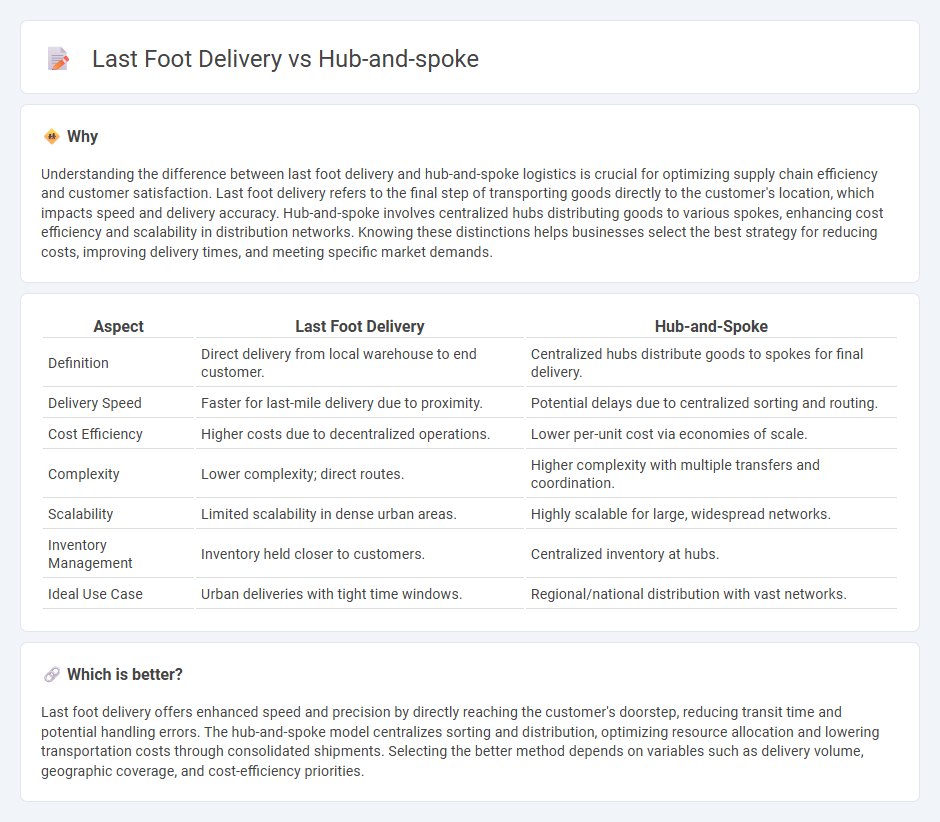
Last mile delivery focuses on transporting goods directly from a local distribution center to the customer, ensuring speed and convenience but often at higher costs per parcel. Hub-and-spoke logistics centralizes shipments through a primary hub, optimizing routes and reducing transportation expenses across long distances before final delivery. Discover how these approaches impact efficiency and customer satisfaction in modern logistics.
Why it is important
Understanding the difference between last foot delivery and hub-and-spoke logistics is crucial for optimizing supply chain efficiency and customer satisfaction. Last foot delivery refers to the final step of transporting goods directly to the customer's location, which impacts speed and delivery accuracy. Hub-and-spoke involves centralized hubs distributing goods to various spokes, enhancing cost efficiency and scalability in distribution networks. Knowing these distinctions helps businesses select the best strategy for reducing costs, improving delivery times, and meeting specific market demands.
Comparison Table
| Aspect | Last Foot Delivery | Hub-and-Spoke |
|---|---|---|
| Definition | Direct delivery from local warehouse to end customer. | Centralized hubs distribute goods to spokes for final delivery. |
| Delivery Speed | Faster for last-mile delivery due to proximity. | Potential delays due to centralized sorting and routing. |
| Cost Efficiency | Higher costs due to decentralized operations. | Lower per-unit cost via economies of scale. |
| Complexity | Lower complexity; direct routes. | Higher complexity with multiple transfers and coordination. |
| Scalability | Limited scalability in dense urban areas. | Highly scalable for large, widespread networks. |
| Inventory Management | Inventory held closer to customers. | Centralized inventory at hubs. |
| Ideal Use Case | Urban deliveries with tight time windows. | Regional/national distribution with vast networks. |
Which is better?
Last foot delivery offers enhanced speed and precision by directly reaching the customer's doorstep, reducing transit time and potential handling errors. The hub-and-spoke model centralizes sorting and distribution, optimizing resource allocation and lowering transportation costs through consolidated shipments. Selecting the better method depends on variables such as delivery volume, geographic coverage, and cost-efficiency priorities.
Connection
Last foot delivery depends heavily on the hub-and-spoke model by using centralized hubs to efficiently sort and dispatch shipments to local nodes for final-mile distribution. This structure optimizes route planning and reduces transit times, ensuring faster, cost-effective deliveries directly to the customer's doorstep. Leveraging hub-and-spoke networks enhances operational scalability and service reliability in last foot delivery logistics.
Key Terms
Centralized Distribution
Centralized distribution in hub-and-spoke models streamlines inventory management by consolidating stock at a central hub, reducing storage costs and enhancing order accuracy. This contrasts with last foot delivery, which prioritizes direct shipment from local distribution points, improving delivery speed but often increasing logistical complexity. Explore how centralized distribution optimizes supply chain efficiency and supports scalable last-foot delivery solutions.
Spoke Locations
Spoke locations in hub-and-spoke logistics serve as critical distribution points that consolidate cargo from the central hub before dispatching it to final destinations, optimizing route efficiency and reducing transportation costs. In contrast, last foot delivery emphasizes the direct shipment from local spokes or micro-fulfillment centers to the customer's doorstep, enhancing speed and customer experience in urban areas. Explore more insights on how spoke locations transform supply chain agility and delivery performance.
Final Mile Logistics
Hub-and-spoke models centralize distribution through a main hub, optimizing inventory management and reducing transit costs in final mile logistics. Last foot delivery emphasizes direct, localized delivery from the nearest hub or store to the end consumer, enhancing speed and customer satisfaction in urban areas. Explore more to understand which approach best suits your supply chain needs and delivery goals.
Source and External Links
What is a Hub-and-Spoke Network: 9 Tips, Benefits & ... - The hub-and-spoke network is a centralized model where a central hub organization coordinates directly with multiple spoke partners, streamlining communication, coordination, and resource allocation by limiting spokes' interactions to just the hub.
Spoke-hub distribution paradigm - The spoke-hub system is a transport optimization model organizing routes from various outlying points (spokes) to a central hub, widely used in airlines and logistics since the 1950s to improve efficiency over point-to-point networks.
Hub-spoke network topology in Azure - In Azure cloud architecture, the hub-spoke topology connects multiple spoke virtual networks to a shared hub virtual network hosting common services, enabling centralized connectivity, security controls, and traffic routing across a scalable and secure network environment.
 dowidth.com
dowidth.com